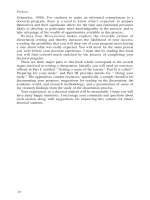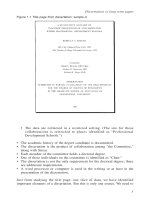Writing your doctoral dissertation - part 24 pptx
Bạn đang xem bản rút gọn của tài liệu. Xem và tải ngay bản đầy đủ của tài liệu tại đây (42.13 KB, 5 trang )
Conducting your study
115
more control over the situation. When descriptive-survey research is
done, this is not the case.
It is not unusual to find oneself changing deadlines when the data
collection is not proceeding as anticipated. Recording the data as they
are collected helps tremendously during this time.
(Smith, 1982, pp. 40–1)
You want to secure all the raw data which you collect at least until your
dissertation has been approved. These data are irreplaceable. With your data
in hand, you are prepared for the next step: analyzing and interpreting your
data, the focus of the next chapter.
116
12 Analyzing and Interpreting Your
Data
I discovered the idea of making a calendar and placing the events on it myself;
it was my very own idea. My chair hadn’t given it to me at all. This was so
exhilarating.
I began to believe that I could write something worthwhile in an interesting
manner—something longer than a report or an essay.
Once you have collected all of your data, your next step is to “make sense”
of the separate pieces of accumulated information. All of the data which you
have collected are frequently called “raw” data because they are untouched
by you. These “raw” data may be standardized test response sheets, tape
recordings of interviews, or unpublished letters. You will need to make
inferences from these discrete pieces of information as you analyze your data.
Before you go any further, I must emphasize the need to clarify your roles
with your chair, since there are significant variations in how the next steps
evolve. In many situations you will work closely with your chair,
collaborating on your progress in analyzing your data. Some chairs want to
participate in every step of the process. Others expect that you will work
totally independently. In the former situation, you take on the role of an
advanced apprentice, gaining confidence in your skills as a researcher while
your chair guides your development. If your chair prefers to let you do it
alone as part of your induction into the research process, you may create
settings where you are able to talk about questions, clarify your procedures,
and generally get useful support and guidance as you pursue this part of your
research. You may find yourself enlisting the assistance of a dissertation
consultant and/or independent researcher. You may go it alone. Take heart in
the knowledge that others have succeeded before you. If they could do it,
you can too!
The culture of your university, your program, and your chair, will dictate
your role. Try to be as protective as possible of your own sanity while finding
ways to develop expertise as an independent researcher. Your collegial
support group reduces your isolation while building your confidence, as you
explore strategies for making sense of your data.
Many students become overwhelmed at this point, not knowing how to
organize their activities, what needs to be done first, or how to proceed to the
Analyzing and interpreting your data
117
point of obtaining “outcomes” or findings. They frequently comment that
they are “drowning in their data.” Basic advice is divide and conquer.
Establish a sequence of several steps, systematically addressing the first step,
then moving on to the next step. In this way, you can track your progress and
know where you are headed. Refer to the checklist in Appendix E as a guide
to creating your own schedule.
It is essential that you keep an open mind in the process of analyzing your
data, remembering that research is conducted to discover, not to prove. You
will need to look carefully at all of the data, seeking to uncover important
insights into the phenomenon which you are researching. Subsequently you
will synthesize all your data sources, creating a more holistic and integrated
set of information which is frequently labeled “findings.” The procedures you
use to accomplish this analysis need to be explicitly documented and directly
connected to your research questions.
Preliminary Organization of your Data
Your first task in responding to research question #1 (and all subsequent ones) is
to convert the discrete pieces of data into a manageable, informative database.
There are some preliminary steps which will get you started on your analysis.
You may not need to wait until you have collected all of your data to start. If you
have collected some data, you probably can start your analysis, or at least
establish procedures for organizing your data beyond the top of your desk. Paper
files and computer databases are two important organizing resources. Into these
numerous files you may place a variety of information, such as:
• standardized test answer sheets;
• coded answer sheets;
• scored standardized test answer sheets using explicit criteria, typically the
publisher’s established correct responses;
• scores of your participants on the standardized test;
• topics discussed on essays;
• summaries of audio-taped classroom lessons;
• copies of your original data;
• descriptions of software programs available in the technology laboratory.
Remember to make copies of all your materials, and place these copies where
they will not be touched by others. You never know when a disaster will strike,
causing you to need to refer to your back-ups.
Starting Your Analysis
Your experience with your pilot or feasibility studies provides an excellent
basis for designing your initial attempts at analysis in your major study. In
Analyzing and interpreting your data
118
your pilot study, you progressed from the separate pieces of data to making
inferences, and then reviewing additional evidence to, for example, confirm
or revise your inferences. One issue should be very clear: the more familiar
you are with your data, the better your analysis will be.
If you ask others to assist in coding your data, transcribing your data, or
in entering your data into the computer, you will not have as deep a
familiarity with your data as those who accept responsibility for all these
steps. Limited familiarity will influence the length of time it may take to
identify important findings. If you ask others to assist you, review their work
with a fine tooth-comb, assuring yourself of the accuracy of what they have
done while becoming informed about all of your data yourself.
Your ability to quote verbatim from your data will lead you to know the
patterns and the aberrations (e.g. an unusually filled-in bubble sheet). This
information will help you to look at your data through more knowledgeable
lenses, and thereby lead you to make more insightful discoveries. While you
are learning your data “by heart” you do not want to drown in them. This
problem is potentially acute in studies that utilize qualitative analysis.
The first goal in analyzing your data is to reduce the information you have
collected to a manageable database, grouping your information in useful
ways. There are numerous ways for you to make your data manageable. You
will access your data more rapidly by reducing the number of papers you
need to refer to. From the large stack of papers which contain your “raw”
data find ways to synthesize or distill the information into a smaller set of
notes which characterize your total data. You want to accomplish this
reduction without losing the qualities which are integral to your total data
set. This reduction process potentially includes creating categories which
describe your data by identifying common qualities or patterns. Or you may
compare one set of data (e.g. test scores) with another set of data (e.g. grade
point average). Your study is only as good as the data which you have to
analyze and the care you take in analyzing them.
Why is Explicit Documentation Important?
Exemplary studies provide sufficient information to enable a reader of the study
to envision all the steps which the researcher followed. By providing a window
into your procedures in analyzing the data, you assure your readers of your
dispassionate, impartial analysis, suggesting that others following the same
procedures would come up with similar findings. Thus, your documentation
includes examples of both the data which are informing your study and the
procedures which you used to analyze these data, transforming the separate
pieces of information into a cohesive response to the research question(s).
This documentation is initially most useful as you review the procedures you
implemented. Your notation of each step will allow you to consider possible
oversights, gaps, and inconsistencies. By reviewing these notes, then, you can
critique your own procedures prior to presenting them to your committee.
Analyzing and interpreting your data
119
When professional colleagues are able to follow your line of reasoning,
they have a basis for valuing the credibility of your study. If they have
difficulty following your thinking due to a sketchy presentation of
procedures, for example, they may have reservations about the way in which
they will value your study. When they can visualize your procedures, they
are more likely to consider your analysis credible.
Another reason for providing careful, step-by-step documentation of your
procedures is to give other researchers, who may seek to replicate your study,
access to your procedures. The aggregation of similar studies is one way in
which theories develop or are strengthened. The more people know about
your precise procedures, the more likely it is that others will consider using
the same or similar procedures. In this way, your study may become a model
for other studies, a wonderful contribution to the research community and an
implicit affirmation of the value of your work.
To accommodate the concern for explicit documentation, you will find it
useful to make careful notes of all the steps you go through in your process
of analysis. This includes even the ones which you subsequently decided
were dead ends. Your explanation of each of these decisions conveys a sense
of care for your analysis and a sense of openness to your readers, again
promoting the credibility of your interpretations.
You will employ a wide range of strategies to make sense of your data,
drawing on three different domains:
1 Your direct experiences with your pilot study and/or your feasibility study.
2 Your understanding of procedures implemented in other studies.
3 General strategies adopted in the research tradition you are following.
Preliminary plans for your data analysis are frequently identified in your
proposal. If you believe your initial plans were ill-conceived, you may need to
redraft your proposal, obtaining approval from your committee for the changes.
Alternatively, you may complete your study, explaining your rationale for
revising your plans. Local norms may influence your decisions in this case.
Direct Connection to Your Research Questions
One way to begin your data analysis is to refer to your initial research
questions which are clearly stated in your proposal. It is not unusual for
students to forget about these, yet they are really important keys to your
analysis. These questions usually identify what you need to analyze.
If you have multiple questions, you probably will find it easier to focus
your attention first on one question. Identify the data which will inform your
understanding of the issues implicit in question #1, for example. After you
have completed a systematic analysis of data to respond to question #1 you
may follow the same strategies with question #2, and so on, until you have
organized all of your data by the research questions. This process is helpful









